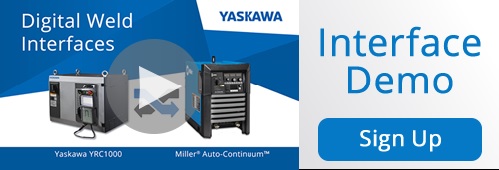The connection and interaction between an industrial robot, welding hardware and robot operator is made successful through a reliable and feature-rich weld interface. In recent years, industrial networking advancements have effectively shifted the market from using analog weld interfaces to digital weld interfaces.
Along with sheer processing power, today’s power sources hold a wealth of process knowledge and weld parameters, with most modern power sources containing hundreds of wire, gas and process combinations—all resident on the power source. These advancements in power source technology and robot interfacing enable better quality welds with faster performance and higher reproducibility.
The Recent Past
Up until the last five years or so, weld interfaces have typically been analog in nature. The technology was such that our engineers and customers would install a weld board into a robot controller, which would generate two to three analog outputs and several discrete outputs to turn the power source on and off. In most cases, a signal would be given for wire feed speed and one would be given for voltage. This was typically the extent of weld interfaces, as seen in Yaskawa’s NX100, XRC, DX100 and other legacy controllers.
For example, with Miller weld interfaces of the past, a voltage signal would correlate directly to wire feed speed, and another voltage signal would control the arc voltage (or “trim” in Miller terms). Despite these limited control parameters, Yaskawa Motoman was still able to provide high-level interface functionality and options for processes like sloping and ramping, where nice starts and ends to the welds could be achieved. Moreover, the ability to ramp up over so many seconds to a certain amperage level or the option to change settings mid-process helped set Yaskawa Motoman apart from other robot OEMs.
The Fourth Industrial Revolution
Manufacturing 4.0 has ushered in revolutionary industrial technologies, and welding interfaces are no exception. Gone are the days of two to three control parameters and general error messages for reporting power source status. The use of Big Data collection and trending analytics is a key driver for the digital revolution taking place. All of this Big Data is now being transferred at very high speeds between a robot, the power source, a weld supervisor’s office PC, and maybe even, “The Cloud”, over just a few wires!
Power source brands like Miller, Lincoln and Fronius have each developed their own brand of technologies and features for effectively transitioning into the digital age. Most power sources now have between four to ten various Central Processing Units (CPUs). Each CPU controls various aspects of the weld process, how the power source responds to the changes in the arc, the user interface, and the communication to and from the robot. Today, much of the communication between CPUs and devices in the weld system is taking place across EtherNet. While these power sources are created for digital interfacing to new robots, most offer “backwards compatible” capability to analog functionality in the event connecting to an older robot is necessary.
One of the largest customer trends in the robotic welding industry is to implement data collection capabilities for the purpose of monitoring changes in the weld process. This area of weld monitoring has greatly progressed in recent years, as modern welding power supplies are equipped to self-monitor their welding performance.
Hundreds (if not thousands) of times a second, the power source will measure its output voltage, wire feed speed, weld time and specific parameters (when applicable), comparing the data collected to predefined limits for the weld in progress. If the power source detects any parameter outside of acceptable limits, that particular weld is marked as “suspect,” and the information related to the weld will be transferred to the robot and robot operator for proper handling.
Miller houses these features within Insight Centerpoint™ arc data monitoring software available within its smart and powerful Auto-Continuum™ power source. Lincoln Electric offers Production Monitoring™, along with a unique WeldScore™ feature that ranks the weld’s overall quality based on the previously mentioned criteria. And, Fronius offers a tool called WeldCube™ that can connect multiple TPSi welders from a single device and generate daily production and quality reports, providing equipment status and health reports.
The Days of Digital Protocol
For Yaskawa Motoman, Miller Auto-Axcess™ DI was the first run of the mill digital welder used for the North American market. Moreover, Yaskawa was the first to mimic the Miller setup application on its robotic teach pendant, allowing users to program the power source directly without needing a Blackberry PDA. As these devices became more difficult to purchase, the Yaskawa interface endured and continues to be used by hundreds of customers today.
As new welding power sources hit the automation market, Yaskawa took what it initially developed for the Miller Auto-Axcess DI and used it as a launch pad to develop industry leading interfaces for Lincoln, Fronius and OTC as well. Today, the most feature-packed interfaces are available on Yaskawa robots, allowing low-level control access, process/production monitoring access, and real-time data display on the robot pendant. All this to say, features that were never possible with analog are now available in abundance.
Next-level Welding Capability
Welding and fabrication are complex processes that can greatly benefit from robotic automation. Today, Yaskawa Motoman has the highest function digital interfaces to major power source brands, allowing users to access setup and manage higher level process information from the robot teach pendant.
Powerful, yet simple, interfaces, like the Miller welding interface for the YRC1000 robot pendant, provide the ability to take welding to the next level. Learn more as Associate Chief Engineer, Chris Anderson, explains the unique features and functions available to help job shops and other manufactures redefine robotic welding as they know it.

Jason Young is a is Associate Chief Engineer, Hardware Solutions Team at Yaskawa America Inc. - Motoman Robotics Division

Connect on: